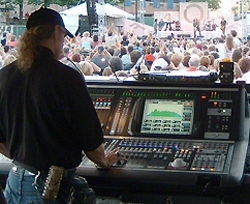
To enable productive communication between the engineers and the musicians, Evans suggests that the FOH engineer should get the musicians to listen to a board tape to get a sense of what’s being sent to the board so it can be refined.
He says, “this way, the FOH engineer can explain and demonstrate to the band the difference between the sound of an empty room and a full room and between loud and soft.”
It takes a lot of time for most musicians to figure out what mix they need. Everybody has their own idea of what musicians need, monitor engineers especially.
Andrew Borger (drums) believes that “once you’ve risen to the challenge of knowing what you need, you need to rise to the challenge of verbalizing it.”
He adds, “my response to that challenge is to ask for as little as possible in the wedge. I like to get as much as possible from the room. A lot of people like to have the kick drum really loud in their mix which usually makes you hit it more softly.
“Although I’m hesitant to admit it in print, to a degree, drums sound better live when you hit ‘em hard. Though I’m not a hard hitter, I want a mix that doesn’t make me play tentatively.”
Borger played in his school band during junior high and high school. He studied jazz and classical music privately from age 11 – 22 and minored in music at UC Berkeley, and has toured the U.S. and Europe with Tom Waits.
In regards to touring with Tom Waits, Borger says “I didn’t have many problems. The monitor engineer was really good. The main challenge I had playing with Tom was that I was spread out physically. I was completely surrounded by instruments.
“At some points I had to go back behind the monitor and play the marimba. The biggest problem we had was figuring out where to put the monitor. Bob, the monitor engineer, really had to watch where I was going and crank the monitor when I wasn’t near it.”
On a more philosophical note, Borger volunteered, “one of my biggest pet peeves is when people make the bass drum fill the entire room. Even though I play some rock and pop and stuff I still like a sparse jazzy feel, but if you fill up the room with the kick there’s no room left for anything else.
“Think of the drum set as not just a kick and a snare, but rather as an entire conglomeration of instruments. From the drummer’s point of view, it’s one instrument. It needs to be balanced.”
Symbolically, most people identify guitar as the defining instrument of rock. Luis Maldonado is a multi-instrumentalist whose primary instrument is guitar.
Maldonado grew up in a musical family, playing guitar since he was 7 and studying it since he was 12. He attended the University of Arizona at Tucson and later graduated from Mira Costa College in Oceanside, CA with 5 different certificates for recording, recording production, live sound, computer/midi/keyboards and engineering.
Maldonado has been doing sessions since 1992 and recently returned from a European tour with UFO (rhythm guitar/keys). He also plays live with Michael Schenker, Dean Del Ray and The Luis Maldonado Group (with Jon Evans on bass and Tim Alexander on drums).
In a live setting, the biggest challenge Maldonado faces is monitors, saying, “you have to have a good monitor engineer who puts in the time to make sure you’re going be able to hear what you need to hear.”
However, he acknowledges that the challenges of getting and maintaining a good keyboard sound on stage are usually greater than those for guitar because with a guitar “you’ve got an amp and a lot of tone control so you can adjust your sound as needed.”
Maldonado attributes his success at getting good sound on stage to the caliber of the monitor engineers he works with but also notes, “I know how to ask for what I need in a way that they understand. Also, being nice helps.”
All of the musicians I interviewed had a lot of technical knowledge and a lot of respect for the difficulties of doing live sound. They all encourage FOH and monitor engineers to keep an open line of communication with the musicians.
Because it takes a lot of time for most musicians to figure out what kind of mix they need, the burden falls on the engineers to work with the musicians, educate them about technical challenges and help them get as close as possible to their ideal mix.
Even though everybody has their own ideas about what musicians need, not everybody is paid to help them get it.
